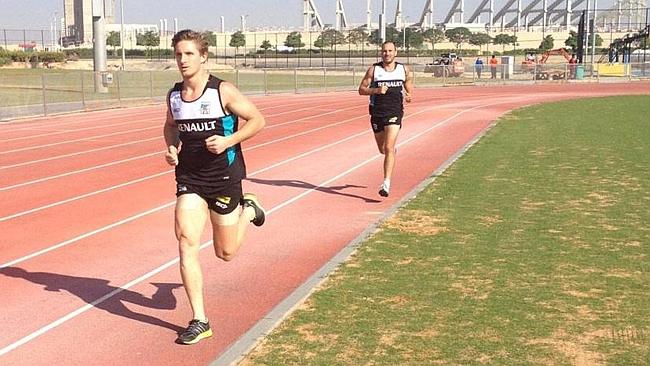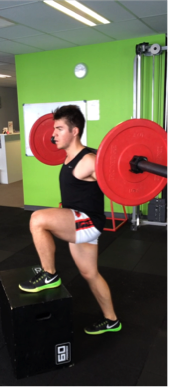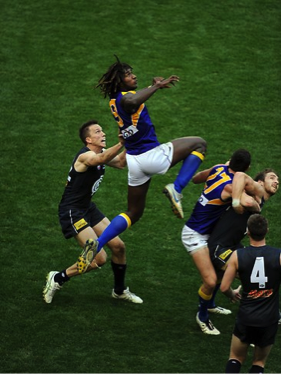Strength Training & Running – Help or Hindrance?
Strength training and running are the 2 most common forms of additional training – or supplementary training – done on top of standard footy training, aimed at developing physical ability for footy. But there is the commonly held belief that the 2 actually hinder each other. That is, improvement in one will detract from the other and vice versa. But is this true? And what to do about it?
If these 2 forms of training are competing with each other and detracting from each other, than this would be a very inefficient way of training. In fact, it would almost be pointless. Why do one form of training and make improvements, but have those improvements eroded by the other form of training? You are almost better off doing nothing. And sadly, a lot of the training out there is like this. It would make more sense if the 2 complemented each other, or at the very least didn’t hinder each other. Thankfully this is actually the case, provided done correctly.
The main key mistake people make when talking about the 2 as interfering with each other, is to think of them as different programs, or separate in a way, with separate goals, that need to somehow be molded together. If you are a regular reader you will know that the central point that we keep coming back to is this; all supplementary physical training has the end-stage goal of improving footy specific expressions of power. These expressions of power of course take on different forms like increased vertical leap, more explosive acceleration, more powerful and efficient deceleration and changing directions, stronger and more efficient tackling, just to name a few. But the point is that we don’t train to be able to run 5km quicker and we don’t train just to be stronger for strengths sake. The end goal is to apply these specifically to powerful movement in footy, or to provide a bigger platform of physical ability, both general and specific, to then build skill on top of.
So if the end goal of both forms of training is to improve footy-specific expressions of power, then it ought to make sense that the 2 do complement each other – as they have the same goal. But like I said, the key underlying factor is provided this is done correctly. Darcy Norman who was working with the German national soccer team explains how strength training can improve running ability;
1. ‘With increased maximal strength the athlete has to produce less relative force per repetition of the skill, which then creates a decreased energy demand.’ In other words, as the muscles and tendons are stronger, the repeated steps in running will require less energy per step, and as a result feel less taxing for the same amount of work.
And:
2. ‘Focusing on maximal strength development helps enhance neural durability and motor recruitment, making the whole system more resilient.’ In other words, with your system being trained to maximally recruit as many muscle fibers and have them and your joints being used to being placed under maximal load (from the strength training), there is less likelihood of soft tissue or over-use injuries occurring.
Great, got it, functional strength training improves running ability for footy. But not just any form of strength training right? Correct. Consider a couple key questions.
What are the goals?
Be clear from the start, what it is specifically that are your primary goals or areas that you would like to improve physically with the extra training. What needs the most work in your game, or what will bring you the most benefit? How important is running to you? If for example, you are a tall tap ruckman, who’s job is primarily to take hit outs, and then rest as an extra loose man down back, and therefore most of your key role is aerial based, it wouldn’t make sense to focus your training efforts on agility work, a high focus on extra running work, and strength exercises designed to improve these and ground ball based contested situations. These things of course would still be important to do some of and have a base level of competency, however, you are much better off focusing more work on double and single leg strength and plyometric exercises to develop vertical leap, as well as core and upper body pushing strength, combined with some running, but not as much as a smaller and more high-speed running based position.
Always consider how the strength exercises will impact on running
Will your strength training exercise selection improve your running ability, or hinder it? And how? Will the bench press that you are doing improve your running ability? No. Will it hinder it? Not directly, but if you put on an extra couple kilograms as a result of all the bench pressing, and you haven’t found any way to enhance your running power, you are in trouble, as you now have a couple extra kilograms to carry around.
Will the leg press improve your running ability? No. What about a step up? Or a lunge? These last 2 exercises are interesting. Very functional, and similar movements (step ups are a similar patterns to first step acceleration, walking lunges a similar to actual running, and alternating lunges have the deceleration and changing directions component to them.) However, even these fantastically functional movements need to be then programmed correctly if they are to have a positive effect rather than a limiting effect. So we will use these as an example to explain what I mean.


The purpose of doing exercises like these (in terms of their effect on running – they will also contribute to other goals like vertical leap) is to enhance your power-per-step in running, and therefore improve efficiency. In other words, give you the ability to achieve more output for the same amount of effort. To truly achieve this, this is where periodisation comes in. There’s that word again.
You would begin with general base conditioning of these 2 movements; doing sets of 8 repetitions approximately, at increasing weights, both in session and from week to week.
Step ups 4 x 8 each leg 35kg, 45kg, 50kg, 50kg
Walking lunges 4 x 8 each leg 30kg, 40kg, 45kg, 55kg
Following 5-6 weeks, the focus shifts to converting this base developed to more intense form of strength, with lower repetitions, and higher weights;
Step ups 3-4 x 6 each leg 45kg, 55kg, 60kg, 65kg
Walking lunges 3-4 x 6 each leg 40kg, 50kg, 55kg, 65kg
Following 4 weeks of this, the next stage is to convert it to power – or quick movement;
Day 1
Lunge-step-jump 3 x 6 each leg stop as soon as height drops
Jump lunge 3 x 6 each leg stop as soon as speed and height drop
Day 2
Step ups 3-4 x 4 each leg 50kg, 60kg, 65kg, 70kg
Walking lunges 3-4 x 4 each leg 45kg, 55kg, 60kg, 70kg
This is one example, another way of challenging such movements and adding in the speed component is to combine the strength exercise, immediately followed by the plyometric exercise;
Step ups 3-4 x 4 each leg Followed immediately by
Lunge-step-jump 3 x 6 each leg
Walking lunges 3-4 x 4 each leg Followed immediately by
Jump lunge 3 x 6 each leg
As I said in the last point this can be done in a number of ways – there is no one way to program and layout a great plan to achieve a goal, only specific principles to follow. There are many programming variables and ways to adjust. And indeed, what is best for one individual will not be ideal for another.
What we have done here, is point out that weights training will enhance running ability provided it is dome correctly. The first step is choosing functional strength training exercises that will carry over directly to running. We chose 2 as a demonstration here. The next step is to periodise the training of them. The other key ingredient is then to add in the running component too to this equation – which means planning the type of running to do, as well as laying out a weekly plan so that the 2 do not interfere with each other. This will be the focus of part 2 of this discussion.
Strength Coach

